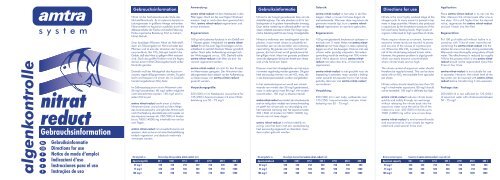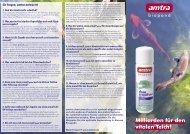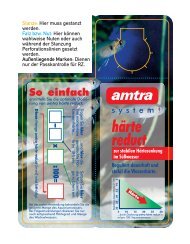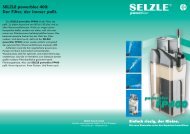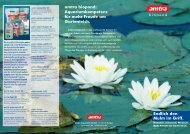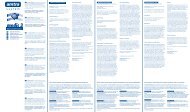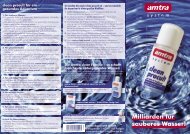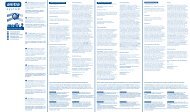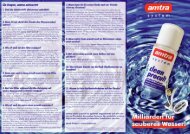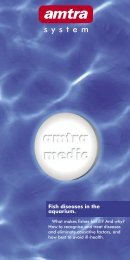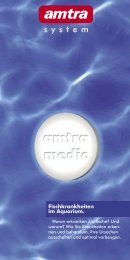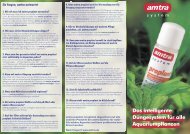Gebruiksinformatie Directions for use Notice de mode d'emploi ...
Gebruiksinformatie Directions for use Notice de mode d'emploi ...
Gebruiksinformatie Directions for use Notice de mode d'emploi ...
You also want an ePaper? Increase the reach of your titles
YUMPU automatically turns print PDFs into web optimized ePapers that Google loves.
NL<br />
GB<br />
F<br />
I<br />
E<br />
P<br />
<strong>Gebruiksin<strong>for</strong>matie</strong><br />
<strong>Directions</strong> <strong>for</strong> <strong>use</strong><br />
<strong>Notice</strong> <strong>de</strong> mo<strong>de</strong> d‘emploi<br />
Indicazioni d‘uso<br />
Instrucciones para el uso<br />
Instruções <strong>de</strong> uso<br />
Gebrauchsin<strong>for</strong>mation <strong>Gebruiksin<strong>for</strong>matie</strong><br />
<strong>Directions</strong> <strong>for</strong> <strong>use</strong><br />
Nitrat ist die höchstoxidieren<strong>de</strong> Stufe <strong>de</strong>s<br />
Stickstoffkreislaufs. Es ist vielerorts bereits im<br />
Leitungswasser in größerer Menge vorhan<strong>de</strong>n.<br />
Nitrat entsteht im Aquarium zusätzlich durch die<br />
Abbauprodukte <strong>de</strong>r Fische und starke Fütterung.<br />
Hohe organische Belastung führt zu hohem<br />
Nitrat-Gehalt.<br />
Zwar benötigen Pflanzen Nitrat als Nährstoff,<br />
doch ein Überangebot an Nitrat scha<strong>de</strong>t <strong>de</strong>n<br />
Pflanzen und ist eine <strong>de</strong>r Ursachen <strong>de</strong>r Cryptocorynenfäule.<br />
Bei CO 2 -Mangel besteht die<br />
Gefahr, daß das Nitrat zu giftigem Nitrit reduziert<br />
wird. Doch das größte Problem sind die Algen,<br />
die bei einem Nitrat-Überangebot leicht außer<br />
Kontrolle geraten.<br />
Deshalb muß <strong>de</strong>r Nitratgehalt <strong>de</strong>s Aquariumwassers<br />
regelmäßig gemessen wer<strong>de</strong>n. Es geht<br />
leicht und bequem mit einem <strong>de</strong>r im Zoofachhan<strong>de</strong>l<br />
angebotenen NO 3 -Tests.<br />
Im Süßwasseraquarium ist ein Nitratwert unter<br />
50 mg/l anzustreben. 80 mg/l sollten möglichst<br />
nicht überschritten wer<strong>de</strong>n. 150 mg/l sind in<br />
je<strong>de</strong>m Fall zuviel.<br />
amtra nitrat-reduct senkt einen zu hohen<br />
Nitratwert sicher und schnell auf <strong>de</strong>m Wege<br />
<strong>de</strong>s Ionenaustauschs und gibt das Nitrat auch<br />
nach Erschöpfung <strong>de</strong>s Materials nicht wie<strong>de</strong>r an<br />
das Aquariumwasser ab. 250 (500) ml bin<strong>de</strong>n<br />
bis zu 7000 (14000) mg innerhalb von ein bis<br />
zwei Tagen.<br />
amtra nitrat-reduct ist umweltschonend und<br />
sparsam, <strong>de</strong>nn es kann mit einer Kochsalzlösung<br />
einfach regeneriert und dadurch mehrmals<br />
verwen<strong>de</strong>t wer<strong>de</strong>n.<br />
Anwendung:<br />
amtra nitrat-reduct mit <strong>de</strong>m Netzbeutel in <strong>de</strong>n<br />
Filter legen. Nach ein bis zwei Tagen Nitratwert<br />
messen. Liegt er noch über <strong>de</strong>m gewünschten<br />
Wert, amtra nitrat-reduct regenerieren und<br />
erneut einsetzen.<br />
Regenerieren:<br />
100 g nicht jodiertes Kochsalz in ein Gefäß mit<br />
1 l Wasser geben. Netzbeutel mit amtra nitratreduct<br />
für ein bis zwei Tage hineinlegen und anschließend<br />
in reichlich frischem Wasser gründlich<br />
spülen. Nach je<strong>de</strong>r Aufbereitung verringert sich<br />
<strong>de</strong>r Wirkungsgrad um ca. 10%. Deshalb sollte<br />
amtra nitrat-reduct nicht öfter als drei- bis<br />
viermal regeneriert wer<strong>de</strong>n.<br />
amtra nitrat-reduct ist nicht für <strong>de</strong>n Einsatz<br />
im Meerwasser geeignet. Der Nitratwert <strong>de</strong>s<br />
Leitungswassers kann jedoch vor <strong>de</strong>r Aufbereitung<br />
zu Meerwasser mit amtra nitrat-reduct<br />
gesenkt wer<strong>de</strong>n.<br />
Verpackungsgröße:<br />
250 (500) ml im Netzbeutel, ausreichend für<br />
125 (250) l Aquariumwasser mit einer Nitratbelastung<br />
von 50 - 75 mg/l.<br />
Nitratgehalt ca. Notwendige Menge amtra nitrat-reduct (ml)<br />
Aquariumgröße 50 l 100 l 175 l 225 l 275 l 350 l 400 l<br />
50 mg/l 250 250 250 250 250 500 500<br />
75 mg/l 250 250 500 500 500 750 1000<br />
100 mg/l 250 500 500 750 750 1000 1000<br />
Nitraat is <strong>de</strong> hoogst geoxi<strong>de</strong>er<strong>de</strong> fase van <strong>de</strong><br />
stikstofkringloop. Op vele plaatsen is dit in het<br />
leidingwater al in grotere hoeveelhe<strong>de</strong>n anwezig.<br />
Door sterke voe<strong>de</strong>ring en afbraakstoffen van <strong>de</strong><br />
vissen ontstaat eveneens nitraat. Een hoge organische<br />
belasting leidt tot een hoog nitraatgehalte.<br />
Nitraat is weliswaar een voedingsstof voor <strong>de</strong><br />
planten, maar teveel nitraat is scha<strong>de</strong>lijk en<br />
bovendien een van <strong>de</strong> oorzaken voor crytocoryneenrotting.<br />
Bij gebrek aan CO 2 bestaat het<br />
gevaar, dat het nitraat wordt gereduceerd tot<br />
het giftige nitriet. Maar het grootste probleem<br />
vormt <strong>de</strong> algengroei die bij een teveel aan nitraat<br />
snel uit <strong>de</strong> hand kan lopen.<br />
Daarom moet het nitraatgehalte van het aquariumwater<br />
regelmatig wor<strong>de</strong>n gemeten. Dit gaat<br />
heel eenvoudig met een van <strong>de</strong> NO 3 -tests, die<br />
in <strong>de</strong> dierenspeciaalzaak wor<strong>de</strong>n aangebo<strong>de</strong>n.<br />
In het zoetwateraquarium wordt een nitraatwaar<strong>de</strong><br />
van min<strong>de</strong>r dan 50 mg/l geadviseerd,<br />
maar in ie<strong>de</strong>r geval moet 80 mg/l niet wor<strong>de</strong>n<br />
overschre<strong>de</strong>n. 150 mg/l is absoluut teveel.<br />
amtra nitrat-reduct vermin<strong>de</strong>rt <strong>de</strong> nitraatwaar<strong>de</strong><br />
snel en veilig door mid<strong>de</strong>l van ionenuitwisseling<br />
en geeft het nitraat ook na verzadiging van<br />
het materiaal niet terug aan het aquariumwater.<br />
250 ( 500) ml bin<strong>de</strong>n tot 7000 (14000) mg<br />
binnen een tot twee dagen.<br />
amtra nitrat-reduct is milieuvrie<strong>de</strong>lijk en<br />
zuinig, want het kann met een zoutoplossing<br />
heel eenvoudig opgewerkt en daardoor meer<strong>de</strong>re<br />
malen gebruikt wor<strong>de</strong>n.<br />
Gebruik:<br />
amtra nitrat-reduct in het netje in <strong>de</strong> filter<br />
leegen. Meet u na een tot twee dagen <strong>de</strong><br />
nietraatwaar<strong>de</strong>. Wanneer <strong>de</strong>ze nog boven <strong>de</strong><br />
gewenste waar<strong>de</strong> ligt, kunt u amtra nitratreduct<br />
regenereren en opnieuw gebruiken.<br />
Regenereren:<br />
100 g niet gejo<strong>de</strong>erd keukenzout oplossen in<br />
een bak met 1 l water. Netje met amtra nitratreduct<br />
een tot twee dagen in <strong>de</strong>ze oplossing<br />
leggen en af en toe bewegen. Daarna met veel<br />
schoon water grondig uitspoelen. Na ie<strong>de</strong>re<br />
opwerking wordt <strong>de</strong> werking met 10% vermin<strong>de</strong>rd.<br />
Het is daarom zinvol, amtra nitratreduct<br />
niet vaker dan drie- of viermaal te<br />
regenereren.<br />
amtra nitrat-reduct is niet geschikt voor <strong>de</strong><br />
toepassing in zeewater, maar voordat u leidingwater<br />
opwerkt tot zeewater kunt u het nitraatgehalte,<br />
daarvan met amtra nitrat-reduct<br />
vermin<strong>de</strong>ren.<br />
Verpakking:<br />
250 (500) ml in een netje, voldoen<strong>de</strong> voor<br />
125 (250) l aquariumwater met een nitratbelasting<br />
van 50 - 75 mg/l.<br />
Nitraatgehalte ca. Benodig<strong>de</strong> hoeveelheid amtra nitrat-reduct (ml)<br />
Aquariuminhoud 50 l 100 l 175 l 225 l 275 l 350 l 400 l<br />
50 mg/l 250 250 250 250 250 500 500<br />
75 mg/l 250 250 500 500 500 750 1000<br />
100 mg/l 250 500 500 750 750 1000 1000<br />
Nitrate is the most highly oxidised stage of the<br />
nitrogen cycle. In many areas it is present in tap<br />
water in large quantities. Nitrate is also produced<br />
in aquariums by the breakdown products of the<br />
fish and heavy feeding levels. High levels of<br />
organic matter lead to high quantities of nitrate.<br />
Plants require nitrate as a nutrient, however<br />
excessive nitrate levels are harmful to plants<br />
and are one of the ca<strong>use</strong>s of cryptocoryne<br />
rot. Where too little CO 2 is present there is a<br />
risk of the nitrate being reduced to toxic nitrite.<br />
However, the greatest problem is algal growth<br />
which can easily become uncontrollable<br />
where nitrate levels are too high.<br />
The nitrate content of aquarium water should<br />
there<strong>for</strong>e be regularly tested. This can be done<br />
easily with an NO 3 test available from specialist<br />
pet shops.<br />
Nitrate values should i<strong>de</strong>ally be less than 50<br />
mg/l in freshwater aquariums. 80 mg/l should<br />
not be excee<strong>de</strong>d. 150 mg/l is <strong>de</strong>finitely too high.<br />
amtra nitrat-reduct reduces nitrate levels<br />
quickly and safely through ion exchange<br />
without releasing the nitrate back into the<br />
aquarium water once the active life of the<br />
material is over. 250 (500) ml binds up to<br />
7000 (14000) mg within one or two days.<br />
amtra nitrat-reduct is environmentfriendly<br />
and economical as it can simply be regenerated<br />
and <strong>use</strong>d several times over.<br />
Application:<br />
Place amtra nitrat-reduct in its net into the<br />
filter. Measure the nitrate levels after one or<br />
two days. If it is still higher than the <strong>de</strong>sired<br />
value, regenerate the amtra nitrat-reduct<br />
and put it back into the filter.<br />
Regeneration:<br />
Put 100 g of table salt without iodine in a<br />
container with 1 litre of water. Insert the net<br />
containing the amtra nitrat-reduct into the<br />
solution <strong>for</strong> one or two days, stirring occasionally.<br />
Afterwards rinse thoroughly using plenty of fresh<br />
water. The effectiveness is reduced by roughly<br />
10% by this process which is why amtra nitratreduct<br />
should not be regenerated more than<br />
three or four times.<br />
amtra nitrat-reduct is not suitable <strong>for</strong> <strong>use</strong><br />
in seawater. However, the nitrate level of the<br />
tap water can be lowered with amtra nitratreduct<br />
be<strong>for</strong>e trans<strong>for</strong>ming it into seawater.<br />
Package size:<br />
250 (500) ml in net, sufficient <strong>for</strong> 125 (250) l<br />
of aquarium water with nitrate levels between<br />
50 - 75 mg/l.<br />
Nitrate content approx. Quantity of amtra nitrat-reduct required (ml)<br />
Aquarium capacity 50 l 100 l 175 l 225 l 275 l 350 l 400 l<br />
50 mg/l 250 250 250 250 250 500 500<br />
75 mg/l 250 250 500 500 500 750 1000<br />
100 mg/l 250 500 500 750 750 1000 1000
<strong>Notice</strong> <strong>de</strong> mo<strong>de</strong> d‘emploi Indicazioni d‘uso Instrucciones para el uso Instruções <strong>de</strong> uso<br />
Les nitrates correspon<strong>de</strong>nt à la phase la plus<br />
oxydée du cycle <strong>de</strong> l’azote. Dans beaucoup d’endroits,<br />
l’eau du robinet contient déjà une gran<strong>de</strong><br />
quantité <strong>de</strong> nitrates. Or, dans le aquariums, <strong>de</strong>s<br />
nitrates apparaissent en plus à ca<strong>use</strong> <strong>de</strong>s déchets<br />
organiques <strong>de</strong>s poissons et d’une abondance <strong>de</strong><br />
nourriture. Une quantité élevée <strong>de</strong> ces déchets<br />
provoque une trop <strong>for</strong>te concentration <strong>de</strong> nitrates.<br />
Les plants ont certes besoin <strong>de</strong> nitrates pour se<br />
nourrir, mais dans une proportion trop <strong>for</strong>te,<br />
ces nitrates nuisent aux plantes et sont l’une <strong>de</strong>s<br />
raisons <strong>de</strong> la pourriture <strong>de</strong>s cryptocorynes. Si<br />
la teneur en CO 2 est insuffisante, les nitrates<br />
risquent <strong>de</strong> se réduire en nitrites toxiques. Or,<br />
lorsque la concentration <strong>de</strong> nitrates est trop importante,<br />
les algues sont très difficiles à maîtriser.<br />
Par conséquent, il faut mesurer régulièrement le<br />
taux <strong>de</strong> nitrates dans l’eau <strong>de</strong> l’aquarium. Ceci<br />
est simple et facile à faire grâce aux test NO 3<br />
proposés dans les magasins spécialisés en<br />
aquariophilie.<br />
Dans un aquarium d’eau douce, il est recommandé<br />
<strong>de</strong> maintenir le taux nitrates en <strong>de</strong>ssous<br />
<strong>de</strong> 50 ml/l. Il convient <strong>de</strong> ne pas dépasser si<br />
possible 80 mg/l. Un taux <strong>de</strong> 150 mg/l est en<br />
tout cas beaucoup trop élevé.<br />
amtra nitrat-reduct réduit un taux <strong>de</strong> nitrates<br />
trop élevé <strong>de</strong> manière sûre et rapi<strong>de</strong> par échange<br />
d’ions et même lorsque sa capacité d’absorption<br />
est épuisée, il ne rejette pas le nitrates dans l’eau<br />
<strong>de</strong> l’aquarium. 250 (500) ml absorbent jusqu à<br />
7000 (14000) mg <strong>de</strong> nitrates en un à <strong>de</strong>ux jours.<br />
amtra nitrat-reduct est économique et favorable<br />
à l’environnement, car une solution à<br />
base d’eau salée permet <strong>de</strong> le régénérer et par<br />
conséquent <strong>de</strong> le réutiliser plusieurs fois.<br />
Utilisation:<br />
Mettre le produit amtra nitrat-reduct avec le<br />
filet dans le filtre. Mesurer le taux <strong>de</strong> nitrates un<br />
à <strong>de</strong>ux jours plus tard. Si le taux mesuré est<br />
encore supérier au taux souhaité, régénérer<br />
simplement le produit et le remettre en œuvre.<br />
Régénération:<br />
Mettre 100 g <strong>de</strong> sel non jodé dans un récipient<br />
avec 1 l d’eau. Mettre le filet avec le produit<br />
amtra nitrat-reduct dans cette eau salée pendant<br />
un à <strong>de</strong>ux jour et le remuer <strong>de</strong> temps en<br />
temps. Rincer ensuite le produit dans une gran<strong>de</strong><br />
quantité d’eau fraîche. Après chaque traitement,<br />
sa capacité d’absorption diminue d’environ<br />
10%. Aussi, il convient <strong>de</strong> ne pas régénérer<br />
amtra nitrat-reduct plus <strong>de</strong> trois à quatre<br />
fois.<br />
amtra nitrat-reduct ne convient pas pour l’eau<br />
<strong>de</strong> mer. La teneur en nitrates <strong>de</strong> l’eau du robinet<br />
peut toutefois être abaissée avec <strong>de</strong> l’amtra<br />
nitrat-reduct avant le traitement en eau <strong>de</strong> mer.<br />
Emballage:<br />
250 (500) ml en filet pour 125 (250) l d’eau<br />
d’aquarium dont la teneur en nitrates est <strong>de</strong><br />
50 - 75 mg/l.<br />
Teneur en nitrates env. Quantité nécessaire d’amtra nitrat-reduct (ml)<br />
Volume <strong>de</strong> l’aquarium 50 l 100 l 175 l 225 l 275 l 350 l 400 l<br />
50 mg/l 250 250 250 250 250 500 500<br />
75 mg/l 250 250 500 500 500 750 1000<br />
100 mg/l 250 500 500 750 750 1000 1000<br />
Il nitrato è il gradino tossico più alto <strong>de</strong>l ciclo<br />
<strong>de</strong>ll’azoto. In molte regioni esso è già presente<br />
in notevole quantità nell’acqua potabile. Il<br />
nitrato si <strong>for</strong>ma inoltre nell’acquario attraverso<br />
gli escrementi <strong>de</strong>i presci e l’abbondanza di mangime.<br />
Una quota elevata di materiale organico<br />
porta alla <strong>for</strong>mazione di valori alti di nitrato.<br />
Le piante hanno bisogno di nitrato come sostanza<br />
nutritiva, però una sovrabbondanza di nitrato fa<br />
male ad esse ed è una <strong>de</strong>lle ca<strong>use</strong> <strong>de</strong>l putredine<br />
<strong>de</strong>i criptocorini. Dalla mancanza di CO 2 c’è il<br />
pericolo che il nitrato viene ridotto nel velenoso<br />
nitrito. Però il più gran<strong>de</strong> problema sono le alghe<br />
che, alla presenza di nitrato in sovrabbondanza,<br />
possono facilmente diventare incontrollabili.<br />
Per questo il valore <strong>de</strong>l nitrato <strong>de</strong>ll’acqua<br />
<strong>de</strong>ll’aquario <strong>de</strong>ve essere regolarmente controllato.<br />
E’possibile farlo facilmente e comodamente<br />
con il test NO 3 che viene offerto nei negozi<br />
specializzati.<br />
Negli acquari d’acqua dolce bisogna cercare<br />
di arrivare ad un valore di nitrato al di sotto<br />
di 50mg/l. 80 mg/l non dovrebbero essere<br />
superati. 150 mg/l sono in ogni caso troppo.<br />
amtra nitrat-reduct abbasssa un valore di<br />
nitrato troppo alto in modo sicuro e rapido, sulla<br />
base <strong>de</strong>llo scambio di ioni e non ridà il nitrato<br />
all’acqua <strong>de</strong>ll’acquario, neanche dopo l’esaurimento<br />
<strong>de</strong>l materiale, 250 (500 ) ml legano fino<br />
a 7000 (14000) mg nel giro di uno, due giorni.<br />
amtra nitrat-reduct è economico ed aconomico,<br />
perché esso può essere rigenerato in una<br />
soluzione di sale e quindi può essere usato più<br />
volte.<br />
Uso:<br />
Immettere amtra nitrat-reduct nel filtro insieme<br />
alle rete che lo avvolge. Dopo uno fino a due<br />
giorni misurare il valore <strong>de</strong>l nitrato. Se è ancora<br />
al di sopra <strong>de</strong>l valore <strong>de</strong>si<strong>de</strong>rato, rigenerare<br />
l’amtra nitrat-reduct ed immettere di nuovo<br />
nel filtro.<br />
Rigenerazione:<br />
Immettere 100 g di sale senza iodio in un recipiente<br />
con 1 litro d’acqua. Mettere <strong>de</strong>ntro la rete<br />
contenente l’amtra nitrat-reduct per uno fino a<br />
due giorni e di tanto in tanto agitare. Alla fine<br />
sciacquare accuratamente in abbondante acqua<br />
fresca. Dopo ogni rinnovo diminuisce il grado<br />
d’azione di circa il 10%. Per questo non si<br />
dovrebbe rigenerare l’amtra nitrat-reduct più<br />
di tre, quattro volte.<br />
amtra nitrat-reduct non è indicato per l’impiego<br />
in acqua marina. Il valore <strong>de</strong>l nitrato<br />
<strong>de</strong>ll’acqua potabile può essere abbassato con<br />
amtra nitrat-reduct prima <strong>de</strong>lla preparazione<br />
ad acqua di mare.<br />
Contenuto <strong>de</strong>l pacco:<br />
250 (500) ml in sacchetto a rete, sufficiente<br />
per 125 (250) l d’acqua d’acquario con un<br />
valore di nitrato di 50 - 75 mg/l.<br />
Gran<strong>de</strong>zza <strong>de</strong>ll’acquario<br />
Valore <strong>de</strong>l <strong>de</strong> nitrato di circa. Quantità indispensabile di amtra nitrat-reduct (ml)<br />
Gran<strong>de</strong>zza <strong>de</strong>ll’acquario 50 l 100 l 175 l 225 l 275 l 350 l 400 l<br />
50 mg/l 250 250 250 250 250 500 500<br />
75 mg/l 250 250 500 500 500 750 1000<br />
100 mg/l 250 500 500 750 750 1000 1000<br />
El nitrato correspon<strong>de</strong> a la fase <strong>de</strong> mas alta oxidactión<br />
en el ciclo <strong>de</strong>l nitrógeno. Según los lugares,<br />
el agua <strong>de</strong> grifo contiene una concentractión consi<strong>de</strong>rable<br />
<strong>de</strong> nitratos. En el acuario, el nitrato se<br />
<strong>for</strong>ma adicionalmente a través <strong>de</strong> las excreciones<br />
<strong>de</strong> los peces y <strong>de</strong>bido a una alimentación abundante.<br />
El recargo orgánico Ileva aparejado una<br />
elevada concentración <strong>de</strong> nitrato.<br />
Si bien es verdad que las plantas precisan substancias<br />
nutritivas, el contenido excesivo <strong>de</strong> nitrato<br />
daña las plantas y es un motivo <strong>de</strong> la putrefacción<br />
<strong>de</strong> criptocorinas. En el caso <strong>de</strong> falta <strong>de</strong> CO 2 existe<br />
el riesgo <strong>de</strong> que el nitrato se reduzca a nitrito,<br />
substancia <strong>de</strong> características tóxicas. Sin embargo,<br />
el problema principal lo constituyen las algas que<br />
en el caso <strong>de</strong> una presencia excesiva <strong>de</strong> nitrato<br />
pue<strong>de</strong>n convertirse fácilmente en una plaga<br />
incontrolable.<br />
Por consiguiente, el contenido <strong>de</strong> nitrato se ha<br />
<strong>de</strong> medir períodicamente. Ello se pue<strong>de</strong> hacer<br />
muy fácilmente con un test <strong>de</strong> NO 3 tal como lo<br />
ofrecen las tiendas especializadas.<br />
En el acuario <strong>de</strong> agua dulce se ha <strong>de</strong> cuidar <strong>de</strong><br />
que el valdor <strong>de</strong> nitrato se mantenga <strong>de</strong>bajo <strong>de</strong><br />
50 mg/litro. En lo posible, el valor <strong>de</strong> 80 mg/litro<br />
no <strong>de</strong>bería exce<strong>de</strong>rse nunca. 150 mg/litro supone<br />
un valor <strong>de</strong>masiado elevado.<br />
amtra nitrat-reduct reduce el valor <strong>de</strong> nitrato<br />
rápida y seguramente a través <strong>de</strong> un intercambio<br />
<strong>de</strong> iones, sin <strong>de</strong>volver el nitrato al aqua <strong>de</strong>l<br />
acuario aunque la capacidad <strong>de</strong> absorción <strong>de</strong>l<br />
material esté agotada. 250 (500) ml fijan hasta<br />
7000 (14000) mg <strong>de</strong>ntro <strong>de</strong> uno a dos días.<br />
amtra nitrat-reduct es un producto comptible<br />
con el medico ambiente y muy económico, ya<br />
que es sencillamente regenerable en aqua<br />
salada, permitiendo así, su uso reiterado.<br />
Empleo:<br />
Colocar amtra nitrat-reduct con la re<strong>de</strong>cilla en<br />
el filtro. Medir el valor <strong>de</strong> nitrato <strong>de</strong>spués <strong>de</strong> uno<br />
o dos días. De no obtenerse el valor <strong>de</strong>seado,<br />
regenerar amtra nitrat-reduct y volver a<br />
colocar.<br />
Regeneración:<br />
Colocar 100 g <strong>de</strong> sal común no yodada en un recipiente<br />
con 1 l <strong>de</strong> agua. Colocar la re<strong>de</strong>cilla<br />
con amtra nitrat-reduct en el recipiente durante<br />
uno o dos días y agitar <strong>de</strong> vez en cuando. A<br />
continuación enjuagar muy bien con agua pura.<br />
Después <strong>de</strong> cada tratamiento, la capacidad <strong>de</strong><br />
absorción disminuye en aprox. un 10%. Por ello,<br />
amtra nitrat-reduct no <strong>de</strong>bería regenerarse<br />
más <strong>de</strong> tres a cuatro veces.<br />
amtra nitrat-reduct no es apto para ser empleado<br />
en agua <strong>de</strong> mar. Sin embargo, el contenido<br />
<strong>de</strong> nitrato <strong>de</strong>l agua <strong>de</strong> grífo pue<strong>de</strong> reducirse con<br />
amtra nitrat-reduct si se emplea antes <strong>de</strong>l tratamiento<br />
necesario para obtener agua <strong>de</strong> mar.<br />
Tamaño:<br />
250 (500) ml en una re<strong>de</strong>cilla, suficiente para<br />
125 (250) litros <strong>de</strong> agua <strong>de</strong> acuario con un<br />
contenido <strong>de</strong> nitrato <strong>de</strong> 50 - 75 ml/l.<br />
Contenido <strong>de</strong> nitrato aprox. Cantidad necesaria <strong>de</strong> amtra nitrat-reduct (ml)<br />
Tamaño <strong>de</strong>l acuario 50 l 100 l 175 l 225 l 275 l 350 l 400 l<br />
50 mg/l 250 250 250 250 250 500 500<br />
75 mg/l 250 250 500 500 500 750 1000<br />
100 mg/l 250 500 500 750 750 1000 1000<br />
O nitrato é o estágio <strong>de</strong> oxidação máxima da<br />
circulação do azoto. Em muitas regiões ele existe<br />
já em gran<strong>de</strong>s quantida<strong>de</strong>s na água da canalização.<br />
No aquário ele se <strong>for</strong>ma adicionalmente<br />
através dos produtos <strong>de</strong> <strong>de</strong>composição dos peixes<br />
e através da exagerada dosagem <strong>de</strong> ração. Uma<br />
elevada carga <strong>de</strong> produtos orgânicos provoca<br />
um elevado teor <strong>de</strong> nitrato.<br />
Apesar das plantas necessitarem <strong>de</strong> nitrato como<br />
substância nutritiva, o excesso <strong>de</strong>ste elemento<br />
po<strong>de</strong>, contudo, prejudicar as plantas sendo ainda<br />
uma das causas da putrefacção <strong>de</strong> criptocorinas.<br />
Na falta <strong>de</strong> CO 2 existe o perigo que o nitrato se<br />
reduza em nitrito tóxico. Porém, o maior problema<br />
são as algas que, no caso <strong>de</strong> um teor excessivo <strong>de</strong><br />
nitrato, po<strong>de</strong>m crescer <strong>de</strong>scontroladamente.<br />
Por isso, o teor <strong>de</strong> nitrato da água do aquário tem<br />
que ser periodicamente medido. Esta medição<br />
po<strong>de</strong> ser efectuada facilmente e comodamente<br />
empregando-se um dos testes <strong>de</strong> NO 3 que estão<br />
à venda nas lojas especializadas.<br />
Nos aquários <strong>de</strong> água doce <strong>de</strong>ve-se tentar manter<br />
um teor <strong>de</strong> nitrato abaixo <strong>de</strong> 50 mg/l. Na medida<br />
do possível, aconselha-se não exce<strong>de</strong>r um teor <strong>de</strong><br />
80 mg/l. Um teor <strong>de</strong> 150 mg/l já é consi<strong>de</strong>rado<br />
como excessivo.<br />
amtra nitrat-reduct reduz <strong>de</strong> <strong>for</strong>ma segura e<br />
rápida teores <strong>de</strong> nitrato muito elevados, mediante<br />
a troca iónica, não remetendo-o novamente na<br />
água do aquário, mesmo <strong>de</strong>pois do esgotamento<br />
do material activo. 250 (500) ml fixam até 7000<br />
(14000) mg no prazo <strong>de</strong> um até dois dias.<br />
amtra nitrat-reduct é um produto compatível<br />
ao meio ambiente e económico, pois ele po<strong>de</strong><br />
ser facilmente regenerado com uma solução <strong>de</strong><br />
sal <strong>de</strong> cozinha para ser aplicado várias vezes.<br />
Aplicação:<br />
Colocar o saquinho <strong>de</strong> re<strong>de</strong> com amtra nitratreduct<br />
no filtro. Depois <strong>de</strong> um até dois dias medir<br />
o teor <strong>de</strong> nitrato. Se o teor ainda <strong>for</strong> superior ao<br />
valor <strong>de</strong>sejado, regenerar o produto amtra nitratreduct,<br />
con<strong>for</strong>me <strong>de</strong>scrito, e empregá-lo<br />
novamente.<br />
Regeneração:<br />
Misturar num recipiente 100 g <strong>de</strong> sal <strong>de</strong> cozinha<br />
não iodizado com 1 l <strong>de</strong> água. Colocar <strong>de</strong>ntro do<br />
recipiente o saquinho <strong>de</strong> re<strong>de</strong> com amtra nitratreduct<br />
e <strong>de</strong>ixar actuar durante um até dois dias e<br />
agitando-o <strong>de</strong> vez em quando. Depois enxaguar<br />
bem o saquinho <strong>de</strong> re<strong>de</strong> com bastante água<br />
fresca. Em cada operação <strong>de</strong> regeneração reduzse<br />
o grau <strong>de</strong> eficiência em cerca <strong>de</strong> 10%. Por esta<br />
razão, o saquinho <strong>de</strong> amtra nitrat-reduct não<br />
<strong>de</strong>ve ser regenerado mais que três a quatro vezes.<br />
O produto amtra nitrat-reduct não é a<strong>de</strong>quado<br />
para ser aplicado em água salgada.<br />
Porém, o teor <strong>de</strong> nitrato da água da canalização<br />
po<strong>de</strong> ser reduzido com amtra nitrat-reduct antes<br />
<strong>de</strong> se trans<strong>for</strong>mar essa água em água salgada.<br />
Dimensões da embalagem:<br />
250 (500) ml no saquinho <strong>de</strong> re<strong>de</strong>, suficiente<br />
para um volume <strong>de</strong> até 125 (250) l <strong>de</strong> água<br />
<strong>de</strong> aquário, com uma carga <strong>de</strong> nitrato <strong>de</strong><br />
50 - 75 mg/l.<br />
Teor <strong>de</strong> nitrato aprox. Quantida<strong>de</strong> requerida <strong>de</strong> amtra nitrat-reduct (ml)<br />
Capacida<strong>de</strong> do aquário 50 l 100 l 175 l 225 l 275 l 350 l 400 l<br />
50 mg/l 250 250 250 250 250 500 500<br />
75 mg/l 250 250 500 500 500 750 1000<br />
100 mg/l 250 500 500 750 750 1000 1000


